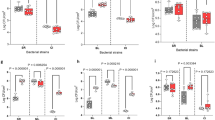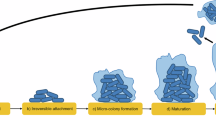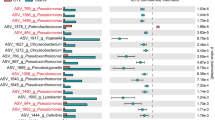Abstract
Biofilms that form on roots, litter and soil particles typically contain multiple bacterial species. Currently, little is known about multispecies biofilm interactions and few studies have been based on environmental isolates. Here, the prevalence of synergistic effects in biofilm formation among seven different soil isolates, cocultured in combinations of four species, was investigated. We observed greater biofilm biomass production in 63% of the four-species culture combinations tested than in biofilm formed by single-species cultures, demonstrating a high prevalence of synergism in multispecies biofilm formation. One four-species consortium, composed of Stenotrophomonas rhizophila, Xanthomonas retroflexus, Microbacterium oxydans and Paenibacillus amylolyticus, exhibited strong synergy in biofilm formation and was selected for further study. Of the four strains, X. retroflexus was the only one capable of forming abundant biofilm in isolation, under the in vitro conditions investigated. In accordance, strain-specific quantitative PCR revealed that X. retroflexus was predominant within the four-species consortium (>97% of total biofilm cell number). Despite low relative abundance of all the remaining strains, all were indispensable for the strong synergistic effect to occur within the four-species biofilm. Moreover, absolute individual strain cell numbers were significantly enhanced when compared with those of single-species biofilms, indicating that all the individual strains benefit from inclusion in the multispecies community. Our results show a high prevalence of synergy in biofilm formation in multispecies consortia isolated from a natural bacterial habitat and suggest that interspecific cooperation occurs.
Similar content being viewed by others
Log in or create a free account to read this content
Gain free access to this article, as well as selected content from this journal and more on nature.com
or
References
Bharathi P, Bhowmick P, Shekar M, Karunasagar I . (2011). Biofilm formation by pure and mixed culture of Lactobacillus isolates on polystyrene surface in varying nutrient conditions. Biotechnol Bioinf Bioeng 1: 93–98.
Burmølle M, Webb JS, Rao D, Hansen LH, Sørensen SJ, Kjelleberg S . (2006). Enhanced biofilm formation and increased resistance to antimicrobial agents and bacterial invasion are caused by synergistic interactions in multispecies biofilms. Appl Environ Microbiol 72: 3916–3923.
Burmølle M, Thomsen TR, Fazli M, Dige I, Christensen L, Homøe P . (2010). Biofilms in chronic infections –a matter of opportunity –monospecies biofilms in multispecies infections. FEMS Immunol Med Microbiol 59: 324–336.
Burmølle M, Kjøller A, Sørensen SJ . (2012). An invisible workforce: biofilms in the soil. In Microbial Biofilms-Current Research and Applications Lear G, Lewis G, (eds). Caister Academic Press: Norfolk, UK, pp 61–72.
Burmølle M, Ren D, Bjarnsholt T, Sørensen SJ . (2014). Interactions in multispecies biofilms: do they actually matter? Trends Microbiol 22: 84–91.
Ceri H, Olson M, Stremick C, Read R, Morck D, Buret A . (1999). The Calgary biofilm device: new technology for rapid determination of antibiotic susceptibilities of bacterial biofilms. J Clin Microbiol 37: 1771–1776.
Daniels R, Vanderleyden J, Michiels J . (2004). Quorum sensing and swarming migration in bacteria. FEMS Microbiol Rev 28: 261–289.
Davey ME, O'toole GA . (2000). Microbial biofilms: from ecology to molecular genetics. Microbiol Mol Biol Rev 64: 847–867.
Davies DG, Parsek MR, Pearson JP, Iglewski BH, Costerton J, Greenberg E . (1998). The involvement of cell-to-cell signals in the development of a bacterial biofilm. Science 280: 295–298.
de la Cruz Perera CI, Ren D, Blanchet M, Dendooven L, Marsch R, Sørensen SJ . (2013). The ability of soil bacteria to receive the conjugative IncP1 plasmid, pKJK10, is different in a mixed community compared to single strains. FEMS Microbiol Lett 338: 95–100.
DeCrescenzo Henriksen E, Phillips D, Peterson J . (2007). Polymyxin E production by P. amylolyticus. Lett Appl Microbiol 45: 491–496.
Diaz PI, Xie Z, Sobue T, Thompson A, Biyikoglu B, Ricker A . (2012). Synergistic interaction between Candida albicans and commensal oral streptococci in a novel in vitro mucosal model. Infect Immun 80: 620–632.
Filoche S, Anderson S, Sissons C . (2004). Biofilm growth of Lactobacillus species is promoted by Actinomyces species and Streptococcus mutans. Oral Microbiol Immunol 19: 322–326.
Foster KR, Bell T . (2012). Competition, not cooperation, dominates interactions among culturable microbial species. Curr Biol 22: 1845–1850.
Hall-Stoodley L, Costerton JW, Stoodley P . (2004). Bacterial biofilms: from the natural environment to infectious diseases. Nature Rev Microbiol 2: 95–108.
Hansen SK, Rainey PB, Haagensen JA, Molin S . (2007). Evolution of species interactions in a biofilm community. Nature 445: 533–536.
Jefferson KK . (2004). What drives bacteria to produce a biofilm? FEMS Microbiol Lett 236: 163–173.
Klayman BJ, Volden PA, Stewart PS, Camper AK . (2009). Escherichia coli O157: H7 requires colonizing partner to adhere and persist in a capillary flow cell. Environ Sci Technol 43: 2105–2111.
Kuramitsu HK, He X, Lux R, Anderson MH, Shi W . (2007). Interspecies interactions within oral microbial communities. Microbiol Mol Biol Rev 71: 653–670.
Lawrence D, Fiegna F, Behrends V, Bundy JG, Phillimore AB, Bell T . (2012). Species interactions alter evolutionary responses to a novel environment. PLoS Biol 10: e1001330.
Lee KWK, Periasamy S, Mukherjee M, Xie C, Kjelleberg S, Rice SA . (2014). Biofilm development and enhanced stress resistance of a model, mixed-species community biofilm. ISME J 8: 894–907.
Mathieu LG, Sonea S . (1995). A powerful bacterial world. Endeavour 19: 112–117.
Morris JJ, Lenski RE, Zinser ER . (2012). The Black Queen Hypothesis: evolution of dependencies through adaptive gene loss. mBio 3: e00036–12.
Møller S, Sternberg C, Andersen JB, Christensen BB, Ramos JL, Givskov M . (1998). In situ gene expression in mixed-culture biofilms: evidence of metabolic interactions between community members. Appl Environ Microbiol 64: 721–732.
Narisawa N, Haruta S, Arai H, Ishii M, Igarashi Y . (2008). Coexistence of antibiotic producing and antibiotic-sensitive bacteria in biofilms is mediated by resistant bacteria. Appl Environ Microbiol 74: 3887–3894.
Palmer RJ Jr, Kazmerzak K, Hansen MC, Kolenbrander PE . (2001). Mutualism versus independence: strategies of mixed-species oral biofilms in vitro using saliva as the sole nutrient source. Infect Immun 69: 5794–5804.
Parsek MR, Greenberg E . (2005). Sociomicrobiology: the connections between quorum sensing and biofilms. Trends Microbiol 13: 27–33.
Rao D, Webb JS, Kjelleberg S . (2005). Competitive interactions in mixed-species biofilms containing the marine bacterium Pseudoalteromonas tunicata. Appl Environ Microbiol 71: 1729–1736.
Ren D, Madsen J, Cruz-Perera C, Bergmark L, Sørensen S, Burmølle M . (2013). High-Throughput screening of multispecies biofilm formation and quantitative PCR-based assessment of individual species proportions, useful for exploring interspecific bacterial interactions. Microb Ecol doi:10.1007/s00248-013-0315-z.
Rickard AH, Gilbert P, High NJ, Kolenbrander PE, Handley PS . (2003). Bacterial coaggregation: an integral process in the development of multispecies biofilms. Trends Microbiol 11: 94–100.
Rodríguez SJ, Bishop PL . (2007). Three-dimensional quantification of soil biofilms using image analysis. Environ Eng Sci 24: 96–103.
Saito Y, Fujii R, Nakagawa KI, Kuramitsu H, Okuda K, Ishihara K . (2008). Stimulation of Fusobacterium nucleatum biofilm formation by Porphyromonas gingivalis. Oral Microbiol Immunol 23: 1–6.
Sharma A, Inagaki S, Sigurdson W, Kuramitsu H . (2005). Synergy between Tannerella forsythia and Fusobacterium nucleatum in biofilm formation. Oral Microbiol Immunol 20: 39–42.
Simões LC, Simoes M, Vieira MJ . (2008). Intergeneric coaggregation among drinking water bacteria: evidence of a role for Acinetobacter calcoaceticus as a bridging bacterium. Appl Environ Microbiol 74: 1259–1263.
Skillman LC, Sutherland IW, Jones MV, Goulsbra A . (1998). Green fluorescent protein as a novel species-specific marker in enteric dual-species biofilms. Microbiology 144: 2095–2101.
Stewart PS, Camper AK, Handran S, Huang C-T, Warnecke M . (1997). Spatial distribution and coexistence of Klebsiella pneumoniae and Pseudomonas aeruginosa in biofilms. Microb Ecol 33: 2–10.
Sørensen SJ, Bailey M, Hansen LH, Kroer N, Wuertz S . (2005). Studying plasmid horizontal transfer in situ: a critical review. Nat Rev Microbiol 3: 700–710.
Wang BY, Kuramitsu HK . (2005). Interactions between oral bacteria: inhibition of Streptococcus mutans bacteriocin production by Streptococcus gordonii. Appl Environ Microbiol 71: 354–362.
West SA, Diggle SP, Buckling A, Gardner A, Griffin AS . (2007). The social lives of microbes. Annu Rev Ecol Evol Syst 38: 53–77.
Yamada M, Ikegami A, Kuramitsu HK . (2005). Synergistic biofilm formation by Treponema denticola and Porphyromonas gingivalis. FEMS Microbio Lett 250: 271–277.
Acknowledgements
We thank Timothy Evison and Urvish Travedi for text edition and Karin Vestberg and Anette Hørdum Løth for technical assistance. This study was partly funded by grants to SJS and MB from the Danish Innovation Consortium SiB, ref no: 11804520, and The Danish Council for Independent Research; ref no: DFF-1335-00071 and ref no: DFF-1323-00235 (SIMICOM).
Author information
Authors and Affiliations
Corresponding authors
Ethics declarations
Competing interests
The authors declare no conflict of interest.
Additional information
Supplementary Information accompanies this paper on The ISME Journal website
Supplementary information
Rights and permissions
About this article
Cite this article
Ren, D., Madsen, J., Sørensen, S. et al. High prevalence of biofilm synergy among bacterial soil isolates in cocultures indicates bacterial interspecific cooperation. ISME J 9, 81–89 (2015). https://doi.org/10.1038/ismej.2014.96
Received:
Revised:
Accepted:
Published:
Issue date:
DOI: https://doi.org/10.1038/ismej.2014.96
This article is cited by
-
Potato root-associated microbiomes adapt to combined water and nutrient limitation and have a plant genotype-specific role for plant stress mitigation
Environmental Microbiome (2023)
-
Gut bacterial consortium enriched in a biofloc system protects shrimp against Vibrio parahaemolyticus infection
Microbiome (2023)
-
ProQ binding to small RNA RyfA promotes virulence and biofilm formation in avian pathogenic Escherichia coli
Veterinary Research (2023)
-
Dynamic social interactions and keystone species shape the diversity and stability of mixed-species biofilms – an example from dairy isolates
ISME Communications (2023)
-
Temporal Succession of Bacterial Community Structure, Co-occurrence Patterns, and Community Assembly Process in Epiphytic Biofilms of Submerged Plants in a Plateau Lake
Microbial Ecology (2023)



